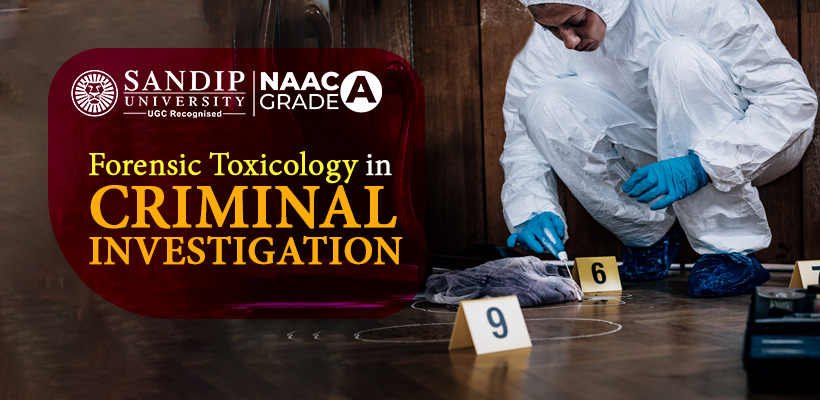In the era of crime investigation, the first thing comes into our mind is evidence – a fingerprint, a knife, a firearm, a glass fragment, or perhaps a pool of blood. These are some evident proofs that the normal eye can locate. But in some circumstances where there are no significant signs of any crime occurrence or where no wound or injury left by any crime weapon, still crime occurs. Some of the best forensic science colleges in Nashik offer cutting-edge programs to train future forensic scientists who can accurately process crime scenes to aid criminal investigations.
There comes the very unique and interesting field of forensic science that is forensic toxicology – a branch of forensic science which deals with detection of invisible markers of crime; poisons, drugs, and toxic substances. Let us further examine the role of forensic toxicology in criminal investigation:
Hidden Weapons of Crime
In the ever-evolving landscape of criminal investigation, not all crimes are committed with a visible weapon. The most lethal weapons frequently leave no knife or bullet wounds. Rather, they quietly infiltrate the victim’s organs, tissues, or bloodstream. Without scientific intervention, these invisible murderers frequently go undetected.
Forensic toxicologists can help with that. They operate behind the scenes to track out toxins, poisons, alcohol, and narcotics that may have contributed to a crime; they are the backstage detectives of the unseen. Investigating unexplained deaths, drug overdoses, industrial accidents, and even doping in sports depends significantly on their work.
What is Toxicology?
Toxicology deals with the characteristics, effects, identification, and effects of harmful substances on living beings. It includes identifying lethal doses, comprehending toxic interactions, and formulating therapies for poisonings.
Paracelsus is recognised as the father of toxicology. He popularly remarked, “All things are poison, and nothing is without poison; only the dose makes a thing not a poison.” This principle established the basis for comprehending how substances like water or oxygen could be harmful when present in excess.
Forensic toxicology, a specialised field that connects toxicology and legal systems. This branch of science studies the effects of chemicals through a legal perspective, whether it pertains to homicide, or an overdose, or substance abuse. Mathieu Joseph Bonaventure Orfila, a Spanish chemist is known to be the pioneering mind behind the advancement of forensic toxicology.
A Brief History of Forensic Science
Since ancient times, poison has been known to be used as a weapon for various reasons. Ancient India, Egypt, Greece and other civilisations have detailed records of poisons and antidotes. Ancient Indian scriptures and records like the Atharva Veda and Charaka Samitha have detailed accounts of different poisons, their symptoms, and remedies.
Indian surgeon Susruta documented how poisons can be infused into food, perfumes, garments, soaps, and medicines to impact a person. Kautilya’s Arthashastra addressed the tactical use of poisons pertaining to intelligence and politics. There are records of skilled poisoners who are able to blend concoctions that conceal taste and smell of poisons to ensure that they go undetected.
Hippocrates from ancient Greece also shared insights into toxins and medicines. Theophrastus shared knowledge on toxic plants in De Historia Planatarum. Centuries later, Avicenna, Rhazes, and Jaber helped advance pharmacology that spread the concept of toxicology through Europe and the Middle East.
The application of anaesthetics in surgical procedures in ancient India — exemplified by the “sammohini” noted in Bhoja-Prabandha (980 A.D.) suggested early understanding of pharmacology.
Rise of Forensic Toxicology in Modern Science
The Renaissance and post-Renaissance eras saw an increase in the organised examination of poisons. During the Middle Ages, Italians refined the skill of poisoning, frequently for political reasons.
However, it was Orfila, during the 19th century, who converted toxicology into a forensic discipline. He methodically examined how toxins influenced the body and performed tests on animals to comprehend their biological impacts. More significantly, he emphasised the necessity of chemical analysis as an essential instrument in legal inquiries. His research served as a model for upcoming toxicologists.
Contributors such as Robert Christison, Rudolf Kobert, Magendie, Ambrose Paré, and Marsh significantly enhanced the discipline.Many of their methods for detecting toxins are still referenced today.
Case Studies: Murder by Poison
Although forensic toxicology might appear to be a calm laboratory discipline, it has solved some of the most disturbing homicide cases on record:
Marie Lafarge Case (1840s, France): Among the initial prominent cases resolved with the application of forensic toxicology. She has used arsenic to poison her husband. Skilled examination of tissue samples revealed the presence of arsenic, creating a premise of toxicology in crime.
The Uthra Murder Case (Kerala, India, 2020): A strange case emerged from Kerala where a man used cobra poison to murder his wife. Prior to the deadly snakebite, she had already been under the influence of drugs. Toxicology confirmed the existence of sedatives in her system — demonstrating the assault was intentional rather than accidental.
Jolly Joseph Case (Kerala, India): A woman killed six relatives over 14 years with cyanide. Toxicology findings disclosed the reasons for the fatalities in every instance, ultimately resulting in her detention and the exposure of a complicated, prolonged crime.
These situations emphasise that forensic toxicology not only detects toxins — it reveals intention, trends, and planning.
Conclusion
Crimes involving knives and firearms might be glaringly visible, yet those carried out with poison can be subtle and intricate. Forensic toxicology guarantees that even the most subtle and hidden types of murder remain detected. Professionals holding a B.Sc. in Forensic Science are able to build forensic knowledge and skills that help them excel in the field of forensics.
From old manuscripts to advanced laboratories, toxicology has developed into a discipline that protects justice. Be it a drop of venom in a drink or a capsule in the circulation, forensic toxicologists diligently strive to make sure that every concealed reality is revealed. In a realm where looks can mislead, forensic toxicology shows us that science is truthful — it uncovers facts.

